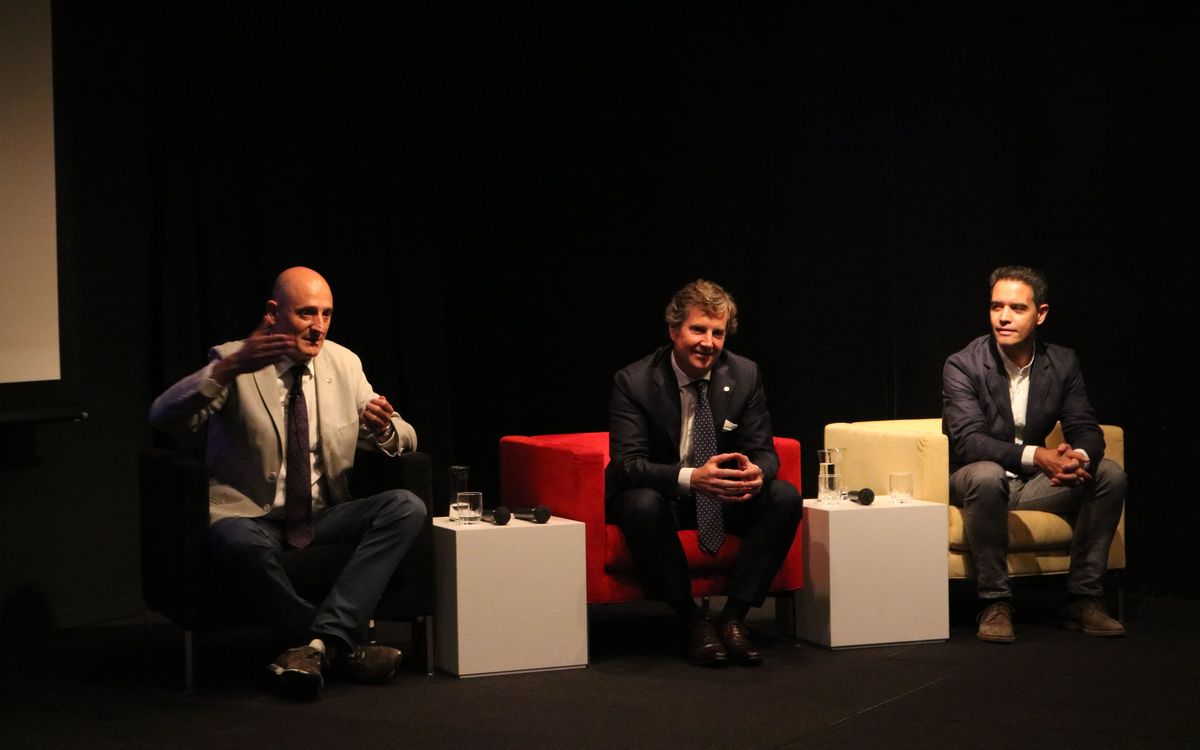Espai Barça presented in Tokyo
- Viber
- Messenger
- Copy link
Jordi Moix, third vice-president of FC Barcelona responsible for Espai Barça, was at the Cervantes Institute in Tokyo on Tuesday to speak about the main features of Espai Barça, one of the key projects in the club’s strategic plan for the next few years. The event was attended by the Spanish ambassador to Japan, Jorge Toledo Albiñana; the manager of the Cervantes Institute, Mavisa Carranza, and the Barcelona City Council Commissioner for Economic Promotion, Business and Innovation, Lluís Gómez. On behalf of FC Barcelona, the Board of Directors’ Delegate for Culture, Teresa Basilio, was also in attendance.
The presentation, titled Architecture and Sport: FC Barcelona, Strategic Projects and Espai Barça was divided into three parts, where Moix was joined by two of the executives who are leading this project: William M. Mannarelli, director of the FC Barcelona Real Estate Area, and Víctor Pageo, Project Manager at Nikken Sekkei, the Japanese architectural and engineering studio behind the proposal.
Jordi Moix begun his speech by explaining the features that define Barça as More than a club, including its values, playing style, social commitment, focus on local talent, multi-sport vocation and ownership model, and how this identity should be combined with the quest for a viable business model that will ensure the club’s sporting and economic future. The 2015-21 Strategic Plan is the instrument being used to achieve this and, within this plan, one of the core areas is Espai Barça.
Before 150 people packing the Auditorium at the Cervantes Institute, Moix also described one of the main elements of the project, the Campus Barça, which involves the remodelling of the stadium environs to integrate them into the neighbourhood and make it the best sports complex in the centre of a major city. Moix recalled that after several failed attempts in the past to remodel its facilities, Espai Barça is finally presenting the club with a project that brings together the key elements of viability and sustainability.
Future Camp Nou, on the horizon for 2024
The third vice-president explained that work on the future Camp Nou should be completed by 2024, although this hangs on whether the Club can obtain the required permit from Barcelona City Council in the coming months in order to commence operations, which will be conducted across four summers to ensure that games in the stadium are not interrupted.
William Mannarelli focused his presentation on the first of the projects to be completed: the Johan Cruyff stadium, which will be inaugurated on August 27 with a match between FC Barcelona and Ajax youth teams. Manarelli described some of the technological innovations included in the stadium and emphasised the quality of the sports facilities and how they will produce the best possible conditions for Barça’s youth and women’s teams.
Víctor Pageo closed the presentation by explaining the background to the current stadium design, based on a concept devised by architect Francesc Mitjans, and how the Nikken Sekkei studio put together the current project. Pageo has also mentioned the different preparatory operations that are already in progress in the stadium.
The Espai Barça was presented in Japan for the first time in December 2015, when FC Barcelona were in the country for that year’s Club World Cup.
Statement by Jordi Moix, third-vice president of FC Barcelona and Commissioner of Espai Barça:
“Espai Barça is a project of major importance to the club. It is one of the strategic operations that will most determine the way it is organised during the next few decades. That is why we have to make sure that, rather than meeting deadlines, it is completed with the utmost efficiency and excellence as required by a club like ours. The priority is to do things well and cause the minimum possible inconvenience to our members and fans”
About Nikken Sekkei
Nikken Sekkei is considered one of the most important architecture and engineering studios in the world, with more than one hundred years of history. They were the architects of the Saitama Super Arena, the Great Swan of Niigata and the Tokyo Dome, all in Japan. Tadao Kamei, its president and CEO, states that the total restructure of the Camp Nou “is the most important Nikken project right now. It is our first project in Western Europe.” Nikken decided to open an office in Barcelona, which is also its general European office, after winning the tender to develop the new Camp Nou in 2016.
- Viber
- Messenger
- Copy link

